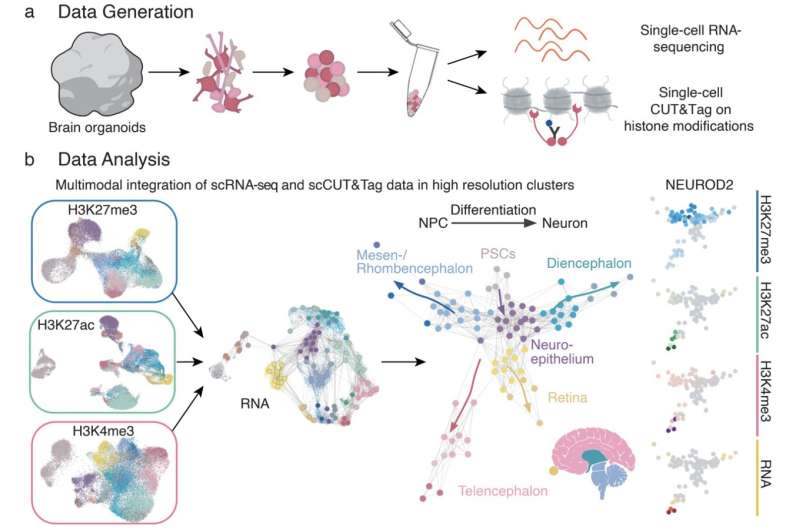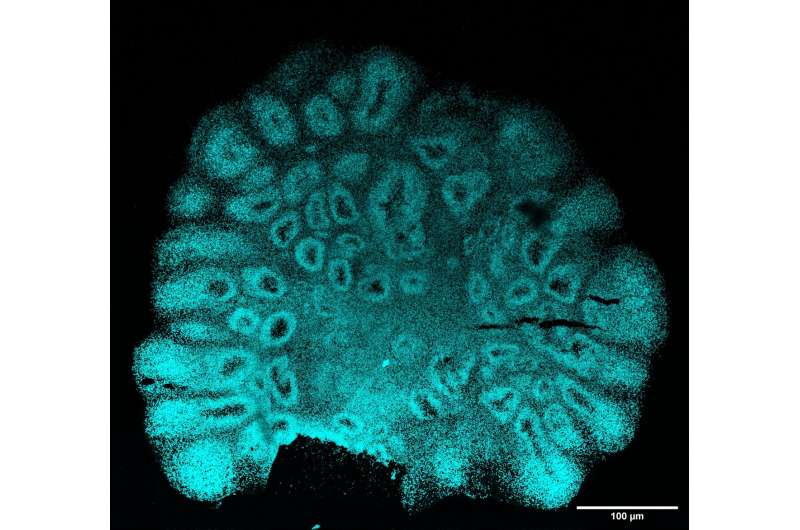- [email protected]
- 27-31 Wright St, Clayton VIC 3168
- Contact
15Jul
Study identifies epigenetic ‘switches’ that regulate the developmental trajectories of single cells
by Elazadeh, 0 Comments


by Ingrid Fadelli
, Medical Xpress
Analysis of the developmental cell atlas. a, Workflow to obtain single-cell RNA (scRNA) expression and CUT&Tag data for three histone modifications (H3K27me3, H3K4me3 and H3K27ac). b, Using MCMF bipartite matching and Cellrank2, we derived multi-omic metacells and constructed a force-directed layout that shows the developmental trajectories from the neuroepithelium into the major brain regions and cellular differentiation states. RNA expression and histone modification enrichment throughout the developmental time course at NEUROD2. PSC, pluripotent stem cell; NPC, neural precursor cell. Credit: Zenk et al
Individual cells in the human body develop progressively over time, ultimately becoming specialized in specific functions. This process, known as cell differentiation or specialization, is central to the formation of distinct cell populations that serve different purposes.
Past studies suggest that the fate of cells is also modulated by epigenetic mechanisms (i.e., interactions between genes and environmental factors). These epigenetic mechanisms, however, have so far been proved difficult to pinpoint.
Researchers at ETH Zurich and Roche Institute of Human Biology recently carried out a study aimed at exploring the epigenetic processes influencing the developmental trajectories of individual cells, using human brain and retina organoids derived from pluripotent stem cells.
Their paper, published in Nature Neuroscience, outlines a single-cell epigenome-wide map that could aid the study of human cell fate determination.
“Our recent paper in Nature Neuroscience was inspired by the need to better understand the epigenetic mechanisms that regulate cell fate decisions during human brain and retina development,” Fides Zenk, co-author of the paper, told Medical Xpress.
“The primary objective was to create a comprehensive single-cell epigenomic map that could capture the transitions from pluripotent stem cells to differentiated neural cells.”
Zenk and her colleagues set out to create a map that could serve as a “blueprint” to explore how activating and repressive histone modification orchestrate the differentiation of cells over the course of their development.

Three-month-old brain organoid stained with DAPI to visualize nuclei. Credit: Zenk et al
To study the epigenetic mechanisms underpinning the diversification of human cells, the researchers carried out experiments on human brain and retina organoids, three-dimensional (3D), miniaturized versions of human organs created in laboratory settings, using pluripotent stem cells.
“We performed single-cell profiling of three key histone modifications: H3K27ac (activating), H3K27me3 (repressive), and H3K4me3 (activating),” Zenk explained. “Using techniques such as CUT&Tag (Cleavage Under Targets and Tagmentation) and single-cell RNA sequencing (scRNA-seq), we mapped these modifications across different developmental stages from pluripotency to differentiated neural states.”
Using epigenetic techniques, the researchers were able to track how these three key histone modifications changed as cells transitioned through different stages of development. The observations gathered in their experiments allowed them to identify dynamic epigenetic “switches” that regulate the fate of individual cells.
“We identified dynamic epigenetic switches that regulate cell fate decisions and created a single-cell epigenomic atlas of human brain and retina development,” Zenk said. “We discovered that the switching of repressive and activating histone modifications happens before cell fate decisions.
“Additionally, we demonstrated that removing H3K27me3 at the neuroectoderm stage disrupts fate restriction, leading to aberrant cell identities.”
The findings of this recent study contribute to the understanding of human cell development and its underlying epigenetic mechanisms. In the future, the team’s results and the map they created could help to shed light on the epigenetic basis of various neurodevelopmental disorders, while also potentially informing the modeling of diseases and the development of new regenerative medicine techniques.
“Our future research plans include further exploring the mechanisms by which histone modifications interact to regulate cell fate decisions and extending our single-cell epigenomic mapping to other organoid models and developmental systems,” Zenk added.
“We also aim to investigate how specific epigenetic modifications contribute to disease states and explore therapeutic interventions that could modulate these epigenetic marks to restore normal cell function.”
More information:
Fides Zenk et al, Single-cell epigenomic reconstruction of developmental trajectories from pluripotency in human neural organoid systems, Nature Neuroscience (2024). DOI: 10.1038/s41593-024-01652-0
Journal information:
Nature Neuroscience
© 2024 Science X Network
